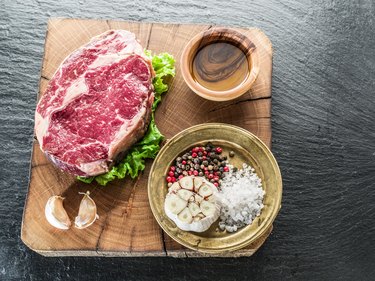
The phrase "turning a sow's ear into a silk purse" is a perfect description of how a cook who knows her way around a beef carcass can take an inexpensive cut of meat and create an extraordinary meal that lingers in your taste-bud memory bank for days. Expensive doesn't necessarily mean tender and flavorful when it comes to cuts of meat. Retail prices of beef vary according to supply and demand, time of year, grass-fed or not, quality of the cut, and quantity available from each steer. But there's no denying that a perfectly seared filet is worth its place at the top of the "most expensive cut of beef" list.
1. Filet ‒ Tip and Whole Tenderloin
Video of the Day
Cut from a small, conical piece of beef that pierces the short loin of a steer, the filet is tender because its placement on the steer means that this portion doesn't have to do anything. There's no muscle, no fat, just meat. Cattle have only two tenderloins. Filet tip, the most expensive cut, is recognizable by its pointed end. The rest of the tenderloin, also sold as filet, appears to be round. Roasts and tournedos are cut from this section. When properly prepared, filet meat is soft and moderately juicy. An outer crispy sear lends contrast to the taste.
Video of the Day
2. Rib-Eye Steaks
Cut from the prime rib, rib-eye steaks are the actual prime rib meat without the bone. While buying a rib-eye with the bone intact adds to the flavor, the added expense of the weight of the bone is off-putting to many. Considered by many to be the best cut of steak, the rib-eye is very succulent and tender because of the marbling and outer fat.
Look for a rib-eye steak that has a swirl of darker meat just below a rim of fat. This steak is cut from ribs five through nine, and the crescent of meat is known as the spinalis muscle. Its flavor melts in your mouth. Prepare a rib-eye steak in a cast iron skillet, basting it with butter.
3. Rib-Eye Roasts
Bone-in, it's known as a prime rib roast and is favored as a holiday meal. The price of the roast varies according to the season, with many butchers selling them for under $6 per pound at Christmas. The prices goes up once the holidays are over.
An elegant presentation, prime ribs are succulent and bursting with flavor. The first cut, from ribs five through nine, feature meat with the spinalis muscle attached, while the cuts from ribs 10‒12 do not. Both cost the same. A boneless prime rib costs more than bone-in because of the waste of bones. You are paying for meat. Just meat.
4. Porterhouse Steak
Past the ribs is the short loin primal area of a steer. It's here that the tenderloin intersects, but it only occupies a small part of the region. Like the rib section, sirloins just go along for the ride. They don't do any work. They have little muscular development and are marbled with fat.
The porterhouse steak features a T-bone, with a strip steak on one side and a filet on the other. What you are eating is the best of both worlds in the land of the cow. The price reflects the fact that a butcher can only get two to three porterhouse cuts from a carcass.
5. Strip Steak
Another cut from the short loin is the strip steak. The butcher takes the porterhouse cut and removes the bone and the filet to create a strip steak. A meaty cut, strips are well-marbled, rimmed in fat and more chewy than a filet. Also known as a New York strip steak, the cut is favored as a grilling meat.
This entire primal section is only 16‒18 inches long, and it produces up to 14 steaks, putting the price point in the $7-plus range per pound. The thinner the cut, the more the butcher has to sell. However, for flavor and to avoid overcooking, ask for a 1-inch minimum cut.